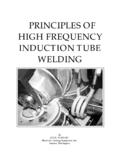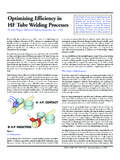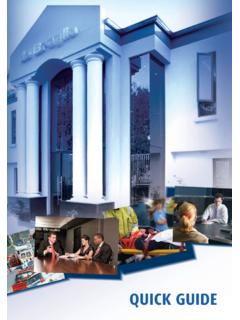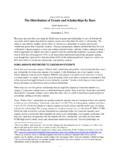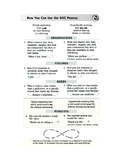Transcription of We receive a lot of questions from our customers ...
1 Electronic Heating Equipment, 1We receive a lot of questions from our customers concerningthe operation of impeders, as well as other topics relating tohigh frequency welding. The following are a selection of themost common questions , together with our are impeders needed for induction welding?Impeders dramatically improve the efficiency of the welding process by directing more energy towards theedges of the strip. The high frequency magnetic field created by the work coil induces a current which flowsaround the outer surface of the tube. Since the tube is still open at this point, the current then transfers ontothe edges of the strip and flows along them to the point where they are forced together by the weld rolls. Thebehavior of electrical currents at high frequencies causes most of the current to be confined to a very thinlayer right at the surface of the strip edge, so rapid heating takes place owing to the resistance of the IMPEDERC urrent flow alongedges of "Vee"WITHOUT IMPEDERC urrent returns oninside of tubeAt 450 kHz.
2 , the typical operating frequency for induction welding, 90% of the current travels within a fewthousandths of an inch of the material surface, so the current sees the inner & outer surfaces of the strip ( & of the tube) as separate conductive paths which are effectively isolated from each other. Withoutan impeder. the current which is induced onto the outside surface of the tube can complete the circuit byreturning on the inside surface. This causes the entire tube to heat up, rather than just the edges, and theenergy wasted in doing so may divert enough power away from the edges of the strip to make can be done to increase the resistance of the inside surface of the strip, but fortunately we are dealingwith high frequencies where resistance is not the only way of opposing current flow. Any electrical circuithas inductive reactance, which like resistance, is measured in Ohms, and which opposes current flow in asimilar manner.
3 Inductive reactance is zero for direct current, but increases linearly with frequency, and canbe further increased by the introduction of a magnetic core. Ferrite is normally used for this purposebecause it is a poor conductor of electricity and does not therefore heat up to the extent that an iron or othermetallic core would. An impeder is simply one or more ferrite cores contained within a suitable it possible to induction weld without using impeders?Impeders are less necessary when welding non magnetic materials. This because the degree of highfrequency skin effect varies among different materials and is most pronounced in carbon steels. BelowCurie temperature, 90% of the current flow in carbon steel is confined to within " of the surface. TheElectronic Heating Equipment, 2skin depth is greater for non magnetic materials, typically " in the case of aluminium.
4 Since currentcannot flow in two opposite directions at the same time, materials that are thinner than twice the skindepth have less need for impeders, and light walled aluminium tubing is often welded without is always some benefit to be gained from using an impeder. In addition to opposing current flowaround the inside surface of the tube, an impeder increases the transfer of energy from the coil to thestrip by focusing the energy in the area where it is needed. The coil has to produce a much stronger(and larger) magnetic field if an impeder is not used, and this causes wasteful and destructive heating ofthe weld rolls and other steel parts in the are a few instances where weld quality may be improved by not using an impeder, and the higherpower requirements may be a worthwhile trade-off. Under normal circumstances the tube edges areheated to a forging temperature that is well below the melting point of the material, but because the highfrequency skin effect concentrates so much energy at the strip edge, the surface will sometimes melt,and this molten material is forced out of the weld area as a result of the pressure applied by the squeezerolls, causing a large, rough weld bead to occur.
5 This overheating may also cause oxidation and if oxidesare not forced out into the bead, weld defects will occur. The heating can be made more gradual byeither moving the coil, the impeder or both, or in some cases eliminating the impeder altogether. Ifimpeders are not used, the voltage across the coil will be much higher, and care must be taken toavoid tube diameters in the 3/4" to 2 1/2" range, induction welding without impeders will normally require50% to 100% more there any special requirements for induction welding stainless steels?Stainless steels present a number of problems. From a mechanical aspect, they have much in commonwith high carbon alloy steels, and they require special roll designs to overcome their resistance to coldforming and to compensate for spring stainless steels have greater hot yield strength, more pressure has to be applied by the weldrolls to create the weld upset.
6 This can be a serious problem with thin-walled tubing because the thinmaterial has very little column strength, and cannot transfer the necessary pressure without steels contain between 5% and 20% Chromium, which oxidizes very readily at the tempera-tures needed for welding. In fact it is this oxide layer that protects the surface of the metal from corrosion,giving it its stainless properties. Oxide inclusions cause weld defects and they must either be forced outof the weld, into the bead, or preferably prevented in the first place. The higher the chromium content,the more difficult it is to weld. Oxidation can be prevented by enclosing the weld area in a low pressureinert shielding gas such as nitrogen. Simply blowing a jet of nitrogen onto the heated part of the tube isnot very effective because additional oxygen from the surrounding air is usually mixed in with the inertgas.
7 Oxygen should be displaced from the inside of the tube as well, since air is carried along with tubing manufacturers believe that using a lower welder frequency can improve weld quality, butthe same effect can be achieved by moving either the coil or the impeder or both upstream to provide alonger heat long should an impeder last?This is one of the most frequent questions we get asked, and one of the hardest to answer. Nothingactually gets used up in an impeder as a result of being exposed to high frequency magnetic fields. AllElectronic Heating Equipment, 3impeder failures occur because the ferrite or casing becomes damaged by mechanical means or exposureto heat. If it is protected from these elements, an impeder should last indefinitely, but as we all know, theydon t, so we should concentrate on extending the life as much as primary cause of failure is overheating.
8 Impeders should be provided with clean water at a minimum of40 PSI. There is no need to use chilled water, but the inlet temperature should not exceed 75 F and shouldbe kept reasonably constant because the magnetic characteristics vary with should also be properly supported inside the tube. Simply hanging one on the end of four feet oftwisted and kinked copper tubing will greatly shorten the life due to vibration and abrasion against the they be recycled?Impeders smaller than about 1-1/2" in diameter are inexpensive, and are not worth trying to salvage. Theremay be some purpose in recycling the brass components, but they are usually worn or distorted to the pointthat their only value is a scrap could theoretically be recycled by re-milling it and forming it into new rods, but the economics are justnot there yet. Ferrite is essentially rust - just oxides of iron, nickel & manganese, all of which are cheap &plentiful.
9 The price of ferrite is a reflection of the highly complex and controlled manufacturing process,which would be equal or greater if recycled material were to be impeders are usually constructed in such a way that they can be repaired by replacing any ferrite thathas been damaged, as well as the outer makes some impeders perform better than others?Many different types of ferrite are available to suit a variety of purposes, but very few are suitable for use inimpeders. Using the wrong grade of ferrite can cause an apparent loss of weld power, as well as prematurefailure of the impeder*.Proper cooling design is also very important. The magnetic characteristics of ferrite vary widely with are the ideal positions for a coil and impeder for various tube sizes?The position of the coil is usually dictated by the design and size of the weld roll assembly.
10 For maximumweld efficiency, the coil should be as close as possible to the weld point. In practical terms, this is usuallyabout equal to the radius of the squeeze rolls. The coil will heat the rolls and support structure if it is tooclose, so it should be far enough way to minimize should be positioned so that the end of the ferrite is just beyond the weld point. (See diagram onthe following page.) Extending the ferrite too far down the tube has no adverse effect, but having it too shortwill cause a dramatic reduction in weld speed. The length of the ferrite should be sufficient that it extendsbeyond the coil for the same distance upstream and are usually positioned close to the centerline of the tube. There is a small gain in efficiency if theferrite is above centerline, as close as possible to the edges of the strip, but it is more vulnerable to heat andmechanical damage in this position.
